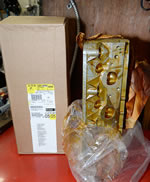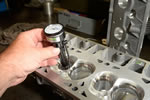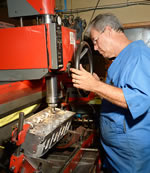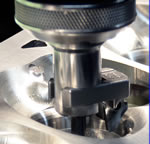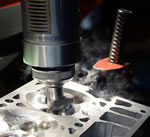Ruthless Pursuit of Power: The Mystique of the C6 Corvette LS7 Engine - Page 24 of 26
Ruthless Pursuit of Power: Lucky Seven Edition: The Mystique of the 7-Liter, 7000-RPM, LS7 - Page 24 of 26
 |
 |
by Hib Halverson
© May 2013— Updated: February 2016
No use without permission, All Rights Reserved
The new heads for our engine came disassembled–two bare heads in boxes and a third box full of parts. Many dealers sublet cylinder head work to local automotive machine shops and Bunnin Chevrolet was no different. In this case, we convinced Bunnin to let us return to DeGroff Cylinder Head Service in the Los Angeles area to have all the parts inspected and the heads assembled rather than having a local machine shop do the work.
In our second session at DeGroff's, the first task was to clean the heads of some sort of preservative which was labeled on the box as meeting "GMSPO Paint Spec #86." We're not sure what that barf-colored, slime was, but it certainly wasn't "paint". It took yours-truly an hour to wash both castings in DeGroff's cleaning tank.
Once the heads were clean, our inspection began and quickly went downhill. Using the Goodson Seat Runout Gauge, we found every intake seat had runout greater than the production maximum of 002-in. and, with half of them, run out was twice or more than the maximum and greater than even the "service" standard GM would adopt eight months later. In short: the replacement heads had a problem with concentricity of intake seats and guides which was worse than the heads which were removed due to guide wear. Mark and I looked at each other and shook our heads in disbelief. "What's up with that?" I asked.
At this point, frustrated with the lack of machining quality in LS7 heads, lacking the time to wait for another set and figuring that, even if I did wait, a second set of new bare heads could be just as bad as the first; I directed Mark DeGroff to refinish all eight of the offending intake seats in the two replacement heads.
DeGroff Cylinder Head Service uses a Serdi Valve Seat Machine which has a workhead which floats on an air cushion. Additionally, that workhead contains a fixed-pilot spindle which floats in its own spherical air cushion. These air cushions allow spindle movement in any plane to ensure centering accuracy and, thus, the concentricity of the valve seat and guide. Serdi calls this an "air-float system" and it ensures concentricity because the spindle aligns with the guide, not the machine table. Once the operator positions the carbide pilot in the guide, the air cushions allow the entire workhead to free-float. That locates the true center of the valve seat by aligning the pilot in the valve guide before any cutting begins. The pilot is lubricated and spins in the guide with .001-mm (.0004-in. or four ten-thousandths of an inch) clearance. The carbide pilots for Serdis are available, .0004-in apart, from sources, such as Goodson.
Serdi cutting tools finish all angles of a valve seat simultaneously, so angles and seat widths are machined with a high level of accuracy. We fitted Degroff's Serdi with a Goodson cutter blade (PN IT-45B-HP) which machines all four angles and the radius used on LS7 intake seats at once. When machined on a Serdi in good condition run by a skilled operator, LS7 seats are going to be concentric within a maximum of .001-inch and will typically have runout numbers less than that.
The trick to fixing seats in new heads which have valve seat runout is to just "touch" them with the cutter such that concentricity between the guide and seat is restored but no additional material is removed from the seat. Getting this just right takes talent and experience, of which Mark DeGroff has plenty—he's had a Serdi since 1996 and has done thousands of heads with it.
 |
 |
